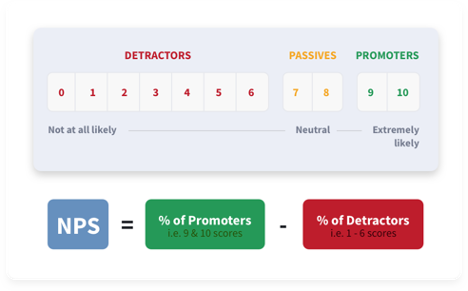Recommendations hold a lot of importance in our society. They are at the heart of providing value to your customers. To give you a perspective, 91% of the people either occasionally or regularly read online reviews, and about 84% of them trust online reviews as much as any personal recommendation. You can also run the NPS program to gather valuable feedback from your customers.
Now, let that sink in.
Taking your brand into consideration, even if you do everything right and aim for perfection at every step and touchpoint, one bad customer experience could do substantially irreparable damage to your business. Furthermore, customers are three times more likely to talk about a bad experience than a good one.
While free-form reviews can be qualitative, it becomes difficult to measure customer feedback and put it to good use this way.
That’s where Net Promoter Score (NPS) surveys come in.
With such surveys, you can understand how customers feel about your brand.
Want to create a killer NPS program for your business? Then dive into this detailed guide to learn the steps to build it and how it can benefit you.
What is Net Promoter Score, or What is NPS?
Watch: What is NPS Score & why do you need it
The Net Promoter Score (NPS) is an excellent metric to determine what your customers feel about your company’s offering: whether you market goods, services, or digital products. In fact, there’s a positive correlation between NPS and 20-60% of a company’s organic growth.
Did you know: NPS(R) is a registered trademark of Bain & Company, developed in 2003 by F. Reichheld!
This is because when you look closely at your Net Promoter Score, you stand to gain more than just a benchmark statistic. Your customer’s reasoning behind their score contributes to your overall NPS and can help explain where you are succeeding and where you should improve.
NPS is a simple question: how likely are you to recommend us on a scale from 0 to 10?
The greatest advantage of NPS is its simplicity. It tends not to ruffle customers’ feathers no matter at which touchpoint in the customer journey they are asked: the start, middle, or end.
How to Calculate NPS
The NPS survey is quite straightforward to serve. The Net Promoter Score definition lays out this single question, which you can tweak to best suit your target customer segments.
People who respond with a 9 or 10 are “promoters.” People who respond with a 7 or 8 are “passive.” People who respond lower than 7 are “detractors.” Fret not – they can be helpful!
Watch how you can easily calculate your Net Promoter Score to improve your CSAT metrics!
Read Also: How (& Why) To Follow up With NPS Survey Detractors
Why is NPS program Important?
Each response you gather is an opportunity to connect with your customers and ideally push them up the scale towards being a Promoter, or if they’re already a Promoter, to be a key referrer. While reaching out to each customer who gives you feedback may be time-consuming, it’s arguably the most critical and possibly the most rewarding aspect of NPS measurement.
Conveying to a customer that you hear them and use their feedback to improve their experience is one of the quickest ways to win them over. Furthermore, following up with your customers allows for them to go into further depth about their opinions and the change they would like to see.
Detractors: For every detractor’s response received on the Net Promoter Score range, you can have a response automatically routed to your customer success Slack channel for immediate response. Check out this article on how to set it up.
Passives: Passives don’t dislike you, but they’re also not your biggest fans. Usually, it has to do with a lack of service or features. You can automatically funnel data to your product team for feature discovery. Promoters: This is a perfect opportunity to create referrals. Automatically send this data to your sales or marketing team to reach out for case studies, enter into a referral program or additional reviews on 3rd party sites.

By strategizing as per the groups of Promoters, Passives, and Detractors, you’re not only saving effort, time, and resources, but you involve the entire organization to be a part of your NPS program. Having participation from every department increases your chances of expanding your customer base.
Related Read: Checkout Best Net Promoter Score Software for 2025
Why Choose NPS Over Other Metrics?
While there are many metrics to measure the success of your business and products/services, NPS surveys are something that companies deploy all over the world for the reasons mentioned below:
1. Inexpensive and Simple
It’s just one simple question that can reveal how loyal a customer is to your company. Without needing elaborate questionnaires, this simple and easy-to-calculate metric can reveal how strongly positive or negative, or indifferent people are about your business.
2. Applicable to Any Business
No matter what business you have, NPS can be used to gauge the sentiments of your customers. NPS surveys can be deployed for any department in your organization and can be easily understood by anyone. Not just customers, NPS can also help measure how loyal employees are to your company which goes a long way in making your business better.
3. Helps With Improvement Program
With follow-up questions to the simple NPS question, you can understand the reasons why people want or don’t want to recommend your company. This understanding can help you improve the net promoter score over time by knowing which direction to take in terms of the required changes.
4. Best for Tracking Change Over Time
Transactional NPS lets you measure loyalty right after a purchase or support request while relational feedback from an NPS survey that’s sent multiple times over a period of time can help you understand how strong of a relationship a customer shares with your company. Depending on the business, these can be sent to track change on a quarterly, annual, or more frequent basis.
5. Lets You Check Repeat Business Opportunities
Knowing that there are a number of promoters out there who are ready to recommend you to others can give you a good idea of people to target for repeat business. This can help you plan business growth, cash-flow, as well as assess the health of your brand and overall customer satisfaction.
Related Read: 8 Ways Market Research Can Help You Grow Your Business
6. Lets You Benchmark on a Global, Industry-Wide Scale
This metric lets you design competitive strategies on a broader level by letting you know how you fare against competitors from your industry in your region as well as all over the world. The same isn’t possible with CSAT surveys that measure smaller and specific interactions.
FREE. All Features. FOREVER!
Try our Forever FREE account with all premium features!
Steps to Build NPS Program
For a successful NPS program, you need to follow a series of steps in the exact order. They are the ‘golden rules’ that you definitely cannot miss out on if you want to build a foolproof NPS program. Let’s have a look at the steps:
Step 1- Set Targets and Define Goals
Setting your goals and defining your objectives is seemingly obvious when you think about accomplishing any task. Even in this case, it is pretty much the same, but you need to make sure that you set Specific, Measurable, Attainable, Realistic, and Time-bound (SMART) targets.
This would allow you to stay focused on the important elements of the task and, most importantly, eventually achieve them.
Things to consider in this step:
- The scope of your targets. The domain into which you are looking to improve your NPS score.
- The metrics that you would use to measure the targets.
- Understanding the clarity of your targets.
- Discuss your targets with everyone to know if it’s achievable.
- To assess the designated time frame of the target.
Step 2- Involvement Is the Key
Business ventures do not operate on singularities do not operate. There are people supporting people, and this is what makes up a strong framework. Similarly, you need to ensure that the top executives of your business are on board with the idea and that you have their unconditional support at every step. This is an effective way of ensuring organization-wide cooperation.
Things to consider in this step:
- The departments that would be involved.
- The role that would be delegated to each department.
- Ensuring that the management has a clear understanding of NPS and the aimed targets.
Step 3- Start Automating
Streamlining your NPS programs and getting rid of most of the manual work is always recommended. This would reduce the overall cost and ensure that the risk of customers slipping through cracks is minimized.
Things to consider in this step:
- The aspects of the workflow that you want to automate.
- The level of automation that you want to implement in each step.
- Which tasks should only be done manually?
Step 4- Use a Reliable Tool
The final step, and arguably the most important, is to use a tool that can perform. There are a diverse set of tasks that you would be throwing at your software, and handling those tasks is extremely important for your NPS program’s success.
This is why we recommend Qualaroo. It is a highly intricate customer feedback tool that has enough capacity to handle any NPS task that you throw at it. Qualaroo specializes in collecting NPS data through various f. With its ability to integrate with tons of popular tools, it is the ideal choice as it gets.
Learn how to create an NPS survey in Qualaroo by watching this easy step-by-step video!
Step 5- Integrate
Make sure that your NPS results are always integrated with the CRM tool that your organization uses. This will allow the data to seamlessly transfer to the CRM tool and be visible to all the employees across the board. This can also influence real-time data updation with quick reporting.
Things to consider in this step:
- To see if the integration is possible with the CRM tool.
- To understand the level of integration and control over the process.
- Steps that you need to take to integrate both tools.
Step 6- Keep It Short and Simple
Customers are never interested in answering long and time-consuming surveys. This is a no-brainer. In fact, 50% of the respondents prefer surveys that have no more than three questions.
Therefore, you need to make sure that the length of the surveys is always at that sweet spot. Customers would never take up a survey at the expense of their time. So make sure to gather all your data in the least number of questions possible.
Things to consider in this step:
- The exact aspects that you need feedback on.
- The type of data that you are looking for.
- The type and number of questions that you would be asking your potential audience.
Related Read: If you want more information about conducting surveys, take a look at The Marketer’s Guide to Surveying Users
Step 7- Damage Control
Damage control is the important bit of the NPS program. Now that you have gathered the audience’s responses and have an accurate idea about your NPS score, it is time to address the issues and work on the pain points based on what detractors have to say.
Statistics say that if you follow up with the detractors in the first 48 hours, you can increase your retention rates by almost 12% and turn those detractors into promoters.
Things to consider in this step:
- Asking follow-up questions to the detractors.
- Factors that made detractors unhappy in the first place.
- What actions can be taken to resolve the customer issues?
- Workflows that need to be implemented to quick action.
- Quickly delegating the task to the right executives.
- Things that you need to do to prevent similar problems from arising again.
Step 8- Follow Up
Little things make the biggest differences. Simply sending a follow-up message such as ‘thank you would remind the customers that their voices have been heard and leave a lasting impression.
According to a stat, over 75% of the NPS executives send ‘thank you’ as a follow-up message. So you might as well.
Things to consider in this step:
- The best and the quickest way of following up with the customers.
- Customers that have not been followed up with.
- The most suitable follow-up messages for the customers.
Step 9- Share the Results
The penultimate step in the process is to share the data both internally and externally. Internally, you need to make people and departments accountable for possibilities to be explored to improve customer experience. You should focus on promoting improvement by aligning daily tasks with the organization’s objectives.
Externally, you need to be transparent towards your customers and other stakeholders. Here, you need to ensure that their feedback has been taken into account and that changes have been made to offer the best possible experience. You can even share some of your customer testimonials to gain a level of trust.
Things to consider in this step:
- The best way of promoting improvement on an individual scale.
- Ways you can show customers how their feedback will be used.
- Ways in which you can increase transparency towards the customers and stakeholders.
NPS Survey Best Practices
Every business needs to create the NPS program uniquely. These pointers help you make your Net Promoter Score formula address your concerns, improve brand image, and grow revenues.
- Involve All Relevant Stakeholders & Teams
Your customers’ satisfaction is not dependent on one team doing their job. It takes a company-wide effort to yield results that reflect positively in your NPS.
- Establish Processes Based on NPS Feedback
Using Sentiment Analysis, you can draw actionable insights from freeform answers given to follow-up questions and set up processes to act on them.
- Align Company Goals With Follow-up Questions
The questions mentioned above can get you the answers to the most pressing issues you feel your company faces: pricing, features, discounts, and others.
- Identify Specific Target Customer Segments
Not every customer follows the customer journey that you and your teams envisioned. Use advanced targeting to ask the right person at the right time.
- Analyze NPS Feedback in the Context of Data
When provided with user consent, demographic data (and personal data) can shed light on the ‘why’ behind your customers’ decisions.
Watch: Qualaroo NPS survey recipes
NPS Program Survey Questions
When it comes to asking questions to the audience, a proper understanding of the questions is also required. NPS surveys yield a lot more than just numeric ratings, provided that you are asking the right questions to the right people.
Below is a list of some Net Promoter Score example questions, broken down into different categories.
To understand the level of satisfaction
- How likely are you to recommend this website to a friend?
- How would you rate our overall service?
- How was your experience on our website?
To investigate bounce rate
- To what extent does this page meet your expectations?
- To what level does this page contain information that you were looking for?
- To what level were you satisfied with the contents of this page?
Uncover missing content
- How sufficient were the topics of this website?
- How useful was this section to you?
- How suitable was the information on this page to you?
To understand issues and exit intent
- How would you rate the clarity of our pricing?
- How would you rate the difficulty in navigating through our website?
- How would you rate the overall prospects of starting a free trial?
When it comes to asking the right question, there is a never-ending list of possible questions that you can pose in front of your audience to get a detailed insight. The key is to always ask the right question to the right people and at the right time.
Related Read- To get a more comprehensive list of possible survey questions, please take a look at What Survey Questions Should I Ask?
Creating an NPS program that helps you tackle vital issues or improve many facets of your business might seem tricky, so here are a few real-life examples of how NPS program helped brands.
FREE. All Features. FOREVER!
Try our Forever FREE account with all premium features!
Net Promoter Score Program Case Studies
1. Belron has two brands that have become synonymous with automobile windscreens: Safelite (in the USA) and Autoglass (in the UK). Windshield repair and replacement is not something about which customers typically feel good.
According to Stephen Payne, Customer Journey Improvement Manager at Belron, “The products that Belron sells are what I call ‘grudge’ purchases. Nobody wakes up and says, ‘I just wonder how much it would cost to get my windshield replaced.” They have to deal with something that they did not want. Every customer wants the easiest possible solution to their unexpected problem – a broken windshield has rendered their vehicle totally unfit to drive.
“The only way that we can continually provide [the easiest possible] experience is by understanding and internalizing what previous customers have told us.”
– Jamie Carter, Voice of the Customer Manager.
So, Belron implemented NPS management in their customer satisfaction processes to gather, process, and act on customer feedback. The happy result: they identified three important factors:
2. USAA is a unique example because they use an internal NPS scale in addition to customer NPS. It is one of the major reasons it achieved top ranks in Forrester’s 2020 Net Promoter Benchmark study, which Forbes analyzed, concluding that USAA’s customer-centricity helped it outshine competitors in the (understandably) fiercely competitive banking & insurance industry.
Lea Sims, USAA’s VP of Employee Innovation, said the initiative gives employees the tools needed to be innovators because “innovation is everyone’s job.”
The benefits of running both external and internal NPS program are two-fold:
- The employees are free to share what they would like to change about the company’s processes
- The customers can see their opinions and suggestions actually implemented, keeping them coming back for more.
3. Slack used the NPS program information shared by customers to improve their bestselling collaboration software and their finer aspects, including – a bit of a surprise – their legal terms of service! Other aspects they improved were their online ads and customer service.
Bill Macaitis, CMO of Slack, summed up his observations about using NPS surveys in this quite relatable way: Every CEO should know the reasons asked for by this very pertinent question:
“What are the top 3 reasons why people recommend and the top 3 reasons why people do not recommend your brand?”
Armed with these answers, CEOs of ambitious companies can retain their existing customers longer to increase their lifetime value (LTV) and add more customers by leveraging their NPS.
4. Entelo is a great example of a SaaS business managing to get existing subscribers to renew their subscriptions and attract more signups by highlighting their best benefits and acting as fast as possible to negative customer feedback gathered in response to NPS surveys.
They took it upon themselves to ensure that existing customers did not feel that their views did not matter. In fact, through unobtrusive in-the-moment surveys, they reacted in record times.
“Some of our customers are actually shocked at how fast we react when a negative comment comes in. We’ve definitely received comments of, “Whoa. I just did this an hour ago. Is this an automated thing?” They think it’s really cool.”
– Loni Spratt, Director, Customer Success
Must Read: How to Leverage NPS for Greater Retention and Product Stickiness
Build Loyalty With Feedback
If done correctly, leveraging Net Promoter Score can help your company cultivate a competitive advantage. More importantly, it can create happier, more loyal clients. If your customers have done you a favor by telling you what they really think, make sure to return it!
Implementing a strategic NPS program is the quickest route to uncovering the ‘why’ behind your users’ decisions. By asking them relevant follow-up questions, you will surely understand them better.
Backed by an intuitive tool like Qualaroo, your program can do even better as it not only lets you ask NPS questions contextually in the most unobtrusive way possible but also helps you understand feedback using one of the most advanced technologies.
 Tips
Tips
We’d love to hear your tips & suggestions on this article!
FREE. All Features. FOREVER!
Try our Forever FREE account with all premium features!


 We'd love your feedback!
We'd love your feedback! Thanks for your feedback!
Thanks for your feedback!







